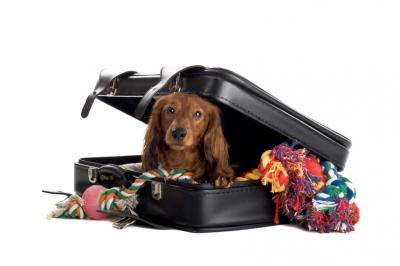Canine Parvovirus Infection in Dogs
The canine parvovirus (CPV) infection is a highly contagious viral illness that affects dogs. The virus manifests itself in two different forms. The more common form is the intestinal form, which is characterized by vomiting, diarrhea, weight loss, and lack of appetite (anorexia). The less common form is the cardiac form, which attacks the heart muscles of very young puppies, often leading to death. The majority of cases are seen in puppies that are between six weeks and six months old. The incidence of canine parvovirus infections has been reduced radically by early vaccination in young puppies.
Symptoms and Types
The major symptoms associated with the intestinal form of a canine parvovirus infection include severe, bloody diarrhea, lethargy, anorexia, fever, vomiting, and severe weight loss. The intestinal form of CPV affects the body's ability to absorb nutrients, and an affected animal will quickly become dehydrated and weak from lack of protein and fluid absorption. The wet tissue of the mouth and eyes may become noticeably red and the heart may beat too rapidly. When your veterinarian palpates (examine by touch) your dog’s abdominal area, your dog may respond with pain or discomfort. Dogs that have contracted CPV may also have a low body temperature (hypothermia), rather than a fever.
Causes
Most cases of CPV infections are caused by a genetic alteration of the original canine parvovirus: the canine parvovirus type 2b. There are a variety of risk factors that can increase a dog’s susceptibility to the disease, but mainly, the virus is transmitted either by direct contact with an infected dog, or indirectly, by the fecal-oral route. Heavy concentrations of the virus are found in an infected dog’s stool, so when a healthy dog sniffs an infected dog’s stool, it will contract the disease. The virus can also be brought into a dog's environment by way of shoes that have come into contact with infected feces. There is evidence that the virus can live in ground soil for up to a year. It is resistant to most cleaning products, or even to weather changes. If you suspect that you have come into contact with feces at all, you will need to wash the affected area with household bleach, the only disinfectant known to kill the virus.
Improper vaccination protocol and vaccination failure can also lead to a CPV infection. Breeding kennels and dog shelters that hold a large number of inadequately vaccinated puppies are particularly hazardous places. For unknown reasons, certain dog breeds, such as Rottweilers, Doberman Pinschers, Pit Bulls, Labrador Retrievers, German Shepherds, English Springer Spaniels, and Alaskan sled dogs, are particularly vulnerable to the disease. Diseases or drug therapies that suppress the normal response of the immune system may also increase the likelihood of infection.
Diagnosis
CPV is diagnosed with a physical examination, biochemical tests, urine analysis, abdominal radiographs, and abdominal ultrasounds. A chemical blood profile and a complete blood cell count will also be performed. Low white blood cell levels are indicative of CPV infection, especially in association with bloody stools. Biochemical and urine analysis may reveal elevated liver enzymes, lymphopenia, and electrolyte imbalances. Abdominal radiograph imaging may show intestinal obstruction, while an abdominal ultrasound may reveal enlarged lymph nodes in the groin, or throughout the body, and fluid-filled intestinal segments.
You will need to give a thorough history of your pet's health, recent activities, and onset of symptoms. If you can gather a sample of your dog's stool, or vomit, your veterinarian will be able to use these samples for microscopic detection of the virus.
Treatment
Since the disease is a viral infection, there is no real cure for it. Treatment is focused on curing the symptoms and preventing secondary bacterial infections, preferably in a hospital environment. Intensive therapy and system support are the key to recovery. Intravenous fluid and nutrition therapy is crucial in maintaining a dog’s normal body fluid after severe diarrhea and dehydration, and protein and electrolyte levels will be monitored and regulated as necessary. Medications that may be used in the treatment include drugs to curb vomiting (antiemetics), H2 Blockers to reduce nausea, antibiotics, and anthelmintics to fight parasites. The survival rate in dogs is about 70 percent, but death may sometimes result from severe dehydration, a severe secondary bacterial infection, bacterial toxins in the blood, or a severe intestinal hemorrhage. Prognosis is lower for puppies, since they have a less developed immune system. It is common for a puppy that is infected with CPV to suffer shock, and sudden death.
Living and Management
Even after your dog has recovered from a CPV infection, it will still have a weakened immune system, and will be susceptible to other illnesses. Talk to your veterinarian about ways by which you can boost your dog's immune system, and otherwise protect your dog from situations that may make it ill. A diet that is easily digested will be best for your dog while it is recovering.
Your dog will also continue to be a contagion risk to other dogs for at least two months after the initial recovery. You will need to isolate your dog from other dogs for a period of time, and you may want to tell neighbors who have dogs that they will need to have their own pets tested. Wash all of the objects your dog uses (e.g., dishes, crate, kennel, toys) with non-toxic cleaners. Recovery comes with long-term immunity against the parvovirus, but it is no guarantee that your pet will not be infected with the virus again.
Prevention
The best prevention you can take against CPV infection is to follow the correct protocol for vaccination. Young puppies should be vaccinated at six, nine, and twelve weeks, and should not be socialized with outside dogs until at least two weeks after their last vaccinations. High-risk breeds may require a longer initial vaccination period of up to 22 weeks.


























